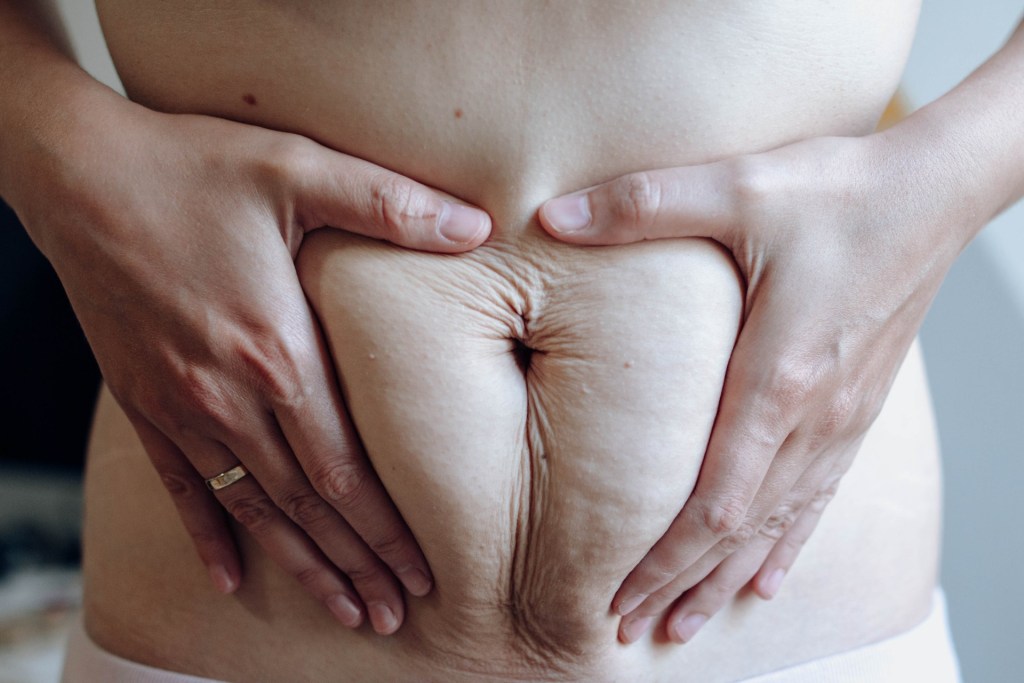
A woman’s body undergoes a lot of changes during a pregnancy. While some women’s bodies seem to snap back following the birth of their baby, others have a more difficult road. If you’ve been struggling with a pooch belly for months following the birth of your little one despite diet and exercise, you could be dealing with diastasis recti.
Most women probably have never heard of diastasis recti or know what it means, but two-thirds of pregnant women will be diagnosed with it. Pregnant women are far more likely to experience diastasis recti but aren’t the only ones who can end up with the diagnosis. Post-menopausal women and even men can experience it as well. So, let’s take a look at what diastasis recti is and what to do if you have it.

Diastasis recti defined
According to MedicalNewsToday, diastasis recti is the separation of the rectus abdominus muscles that run up and down the front of the belly on both sides. The linea alba is the tissue that separates the right and left rectus abdominus muscles. When diastasis recti happens, the linea alba pushes the rectus abdominus muscles further apart. The pushing causes the signature bulging or pooch belly.
Sometimes, diastasis recti can be congenital, but in most cases, the condition occurs because of pregnancy. Diastasis recti is diagnosed by the width of the separation and by its accompanying symptoms. A width of more than three-quarters of an inch is typical in diastasis recti.
Diastasis recti symptoms
While the pooching belly is often a telltale symptom, there can be other indicators of diastasis recti that point toward the condition, including:
- Back pain
- Abdominal pain
- Constipation
- Loss of bladder control
- Poor posture
- Pelvic organ prolapse (organs like the bladder are slipping into the vaginal area)
- Bowel leakage
- Hernia
Risk factors for diastasis recti
Since two-thirds of pregnant women typically experience diastasis recti, risk factors have been associated with the condition, such as:
- Multiple pregnancies
- Being pregnant with multiples (twins, triplets)
- Muscle tone
- Posture
- Hernia
- Prior pelvic issues
- Age
- Weight gain
- Heavy lifting

Do you have diastasis recti?
If you’ve recently given birth and are struggling with a pooch belly and other telltale symptoms, you might be concerned you have diastasis recti. There is a simple self-test you can try to see if you do. First, lay down on the ground in a sit-up position with your feet flat on the floor and your knees bent. Then, place a hand on your belly by your naval. Keeping your shoulders on the ground, pick up your head and press your fingers down. Feel around to see how far apart your rectus abdominus muscles are. If the width is more than two fingers, it could mean you are dealing with diastasis recti. Don’t worry if the width is over two fingers. There are treatment options, and the first step is to make an appointment with your doctor.

Diastasis recti treatment
Exercises geared toward closing the divide between the rectus abdominus muscles can help most cases of diastasis recti. Your doctor may refer you to a physical therapist or a pelvic floor specialist. There are also core strengthening exercises you can do at home. When doing core strengthening exercises, it’s vital to avoid exercises that push the abdomen muscles out. You should avoid crunches, leg lifts, and yoga poses focused on stretching the abdominal muscles. Planks, pelvic floor tilts, and wall sits are ideal when treating diastasis recti.
For some women suffering from diastasis recti, surgery is necessary. This is usually a last resort and one done when women are dealing with more severe symptoms of diastasis recti. As soon as you suspect diastasis recti, contact your physician. The sooner you begin non-invasive treatment options, like an exercise program, the better.

Is diastasis recti preventable?
While diastasis recti may not be fully preventable, there are things women can do to keep the gap between the rectus abdominus muscles to a minimum. These are some ways to try to prevent diastasis recti.
- Try to avoid slouching and think about improving your overall posture.
- Learn how to lift objects correctly, especially heavier things.
- Strengthen your core muscles prior to pregnancy.
- Engage your core when exhaling.
- Participate in an exercise routine before, during, and after pregnancy with a doctor’s approval.
During pregnancy, it can also be helpful to use the log roll method when getting in and out of bed. This method takes the pressure off of the belly.
Most women may not have heard of diastasis recti, but two-thirds of pregnant women experience it. Diastasis recti refers to the separation of the rectus abdominus muscles. It can be self-diagnosed, but if you suspect you have it, contact your physician. Most of the time, diastasis recti is treatable at home or with the help of a physical therapist. Whether it’s your first baby or a subsequent pregnancy, there are some things you can do that may prevent it.



